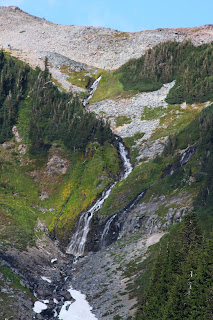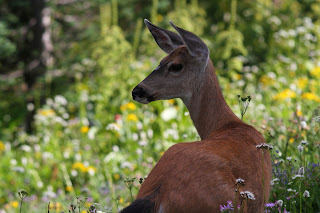The first Europeans to explore this area were the English in 1792. Navy Captain George Vancouver and his crew were the first white men to see it. Captain Vancouver named it in honor of his friend, Rear Admiral Peter Rainier.
The Native Americans living in the area during Captain Vancouver's "discovery" were the Nisqually, Cowlitz, Yakama, Puyallup and Muckleshoot. The common language of these tribes, known as Lushootseed, referred to the mountain as "Talol" or "Tacoma" meaning "mother of waters". Indeed, the many glaciers that sit atop this massive natural structure do support most of the watersheds in the area. Other debated translations include, "she who gives us water", "snow covered mountain" and "the mountain that was god". Also, another axiomatic translation is "larger than Koma (Mount Baker)", another beautiful mountain in the region.
In my own "armchair" anthropological opinion, I think these many translations exist because the mountain meant different things to different people. The way it glimmers like a giant rounded golden mound (on a clear day) in the horizon gives the feeling of the divine. When we were up at Paradise (the farthest point up the mountain you can drive a vehicle) the views of dozens of waterfalls gives the feel of "mother of waters", literally, Mother Earth bringing bountiful waters into fruition. Perhaps the many translations were simply relative to the perspective any particular Native American tribe might have at a given time. Whatever it truly means, it is a place that I highly recommend every person see at some point in their life.
Pertaining to our feathered friends, I saw ONE bird up at Paradise. It was a Dark-eyed Junco. It is part of the Oregon Group, which looks much different than the Slate-colored Group typical of farther East. The Oregon Group is characterized by the black hood that contrasts with the rest of the body colors. DO NOT be let down though, because my upcoming post about my experience on Mount Hood will most definitely make up for the lack of birds seen at Rainier. ;)
Our first close glimpse of Mount Rainier.
We were lucky enough to get some relatively cloud-free pictures.
The Pica, a small rodent that lives among rocky crevices.
A glacier once filled the cavity of this rocky valley not more than half a century ago. A testimony to the rate at which glaciers are melting under Earth's current climatic conditions.
Terminal end of one of the glaciers on Mount Rainier.
There are several other small mountain chains around Mount Rainier. Almost like soldiers standing guard over their king.
We found out that during our stay the wildflowers on Rainier were at their peak. They were so vibrant and absolutely stunning with a multitude of hues and shapes. Not to mention that their backdrop is one of the most beautiful mountains in the country.
Sap oozing out of pine cones. It looked like silver with the sunlight reflecting off of it. This tree was a young Subalpine Fir.
Not hard to see why some of the natives called this place "mother of waters". Some of the pictures above have almost half a dozen waterfalls in them. There are several other larger waterfalls that are popular tourist spots.
Black-tailed Deer after they were spooked by a Black Bear. We unfortunately did not see the bear, however, several groups confirmed that they had just seen it minutes earlier running down the mountain.
Dark-eyed Junco of the Oregon Group.
My finest landscape shot to date! Sending you out with a bang!
























No comments:
Post a Comment